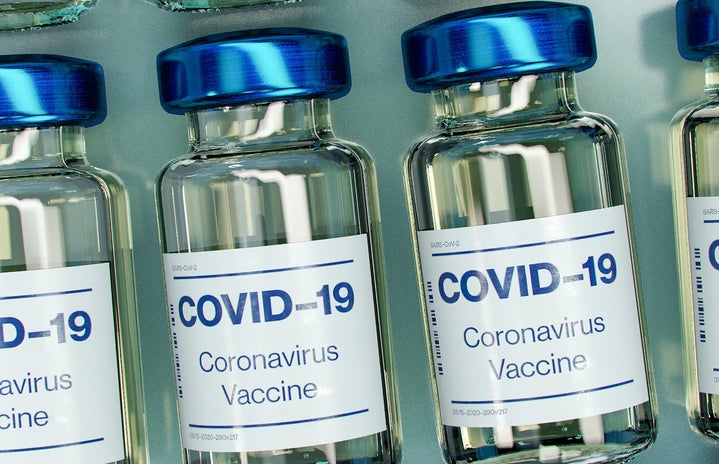The worldwide COVID-19 pandemic has brought countries, economies, and everyday life to a halt. With huge ramifications for public health, it has become apparent that long-term preventative measures were needed to reduce the effects of the virus in communities.
Recent scientific breakthroughs have developed and fostered the distribution of the COVID-19 vaccines. After two doses administered 21-28 days apart, the Pfizer vaccine was found to have an efficacy rate of 94.1% and Moderna was found to be 95% effective. For reference, the annual influenza efficacy rate vaccine hovers around 44% after one dose while the highly controversial MMR (measles, mumps, rubella) vaccine is 97% effective after two doses.
Note: The annual influenza vaccine has such a low efficacy rate because scientists essentially have to predict which flu strains, usually 5-6, will be most prevalent six to ten months in advance of flu season. This comprehensive article from the CDC further clarifies misconceptions about the influenza vaccine.
With the development phase of the vaccine complete, distribution is the next hurdle. Since the FDA granted emergency approval in December, over 55 million doses of the vaccine have been administered. Moderna is expected to deliver 100 million doses to the US by the end of March, May, and July respectively. While many people are lining up to receive their two doses of vaccine, many others are more hesitant. There are a lot of misconceptions and misinformation about vaccines and the COVID-19 vaccine in particular.
Several members of my family work in healthcare: my mom is a dental assistant, my cousin is a nurse, and my dad and uncle work with high-risk groups. They have all received their two doses with minimal side effects (sore arms, fatigue, and in my cousin’s case, a mild fever that lasted a day). Putting an unknown substance in your body is scary but even scarier is knowing your family is constantly exposed to the virus. With three separate cases of exposure between the four of them just in 2021, it was a huge relief when they finally got vaccinated. My parents are very vaccine-friendly but they still didn’t understand how vaccines worked.
Before we dive into an explanation of your immune system, COVID-19, and the vaccine, here are some terms that you should know:
Immune system: organs, cells, and chemicals that help fight pathogens and keep you from getting sick. They are specialized structures to fight specific diseases
Innate immunity: immunity you are born with to prevent your body from getting infected. Generally these are physical, such as your skin, mucous membranes, and stomach acid
Acquired immunity: immunity you acquire throughout your lifetime, often from overcoming an infection or disease, or through vaccinations
Antigen: a molecule, usually a protein, on the outside of a pathogen that triggers an immune response. Fun fact: antigen is short for antibody generator :)
Antibody: proteins that bind to a specific antigen. Created by your immune system after you have been affected or vaccinated
Vaccine: a biological substance that allows for antibody production to provide immunity against specific diseases, does not cause the disease
Herd immunity: when a large percentage of a population is immune to a certain disease. While herd immunity is achievable from 70-70%, it is optimal for 90% of the population be vaccinated to effectively protect individuals who are unable to be vaccinated due to medical reasons such as those who are immunocompromised or with severe allergies
Virus: an infectious agent consisting of either DNA or RNA surrounded by a protein coat. Contrary to popular belief, viruses are not alive. They need a living host cell to replicate themselves. After gaining entry into a host cell, they hijack the machinery that the host cell uses to replicate for itself, often killing the host cell in the process
Spike protein: an identification protein outside of viruses that helps them lock onto cells and gain entry
Central dogma: (DNA -> RNA -> protein) a biological process in which information in DNA is converted to a functional protein product
DNA: deoxyribonucleic acid. Found inside every cell in your body and carries the genetic instructions for the development, function, growth, and reproduction of all organisms and viruses
RNA: ribonucleic acid. A single-stranded nucleic acid that acts as the intermediary between instructive DNA and functional protein. There are many different types of RNA, including mRNA (messenger RNA), tRNA (transfer RNA), and rRNA (ribosomal RNA)
mRNA: messenger RNA. The most diverse of all RNAs, carries complementary genetic codes copied from DNA in nucleotide triplets called codons. Each codon identifies a different amino acid which will ultimately transcribe a protein
Protein: an organic compound made of 20 amino acids. Proteins are an essential component of cells where they provide structural support and have an important role by acting as enzymes, carriers, and hormones
Now that we have covered some basic terminology, let’s dive into some immunology:
Immunity 101
Your immune system has two main functions: preventing infections and fighting infections.
To prevent infections, your skin keeps microbes out of your body. Your nose and ear hairs and eyelashes, filter particles and prevent them from entering your throat, ears, and eyes respectively. Your stomach’s high acidity destroys invaders before they can make you sick.
If something slips past these defenses, your innate immune system works to identify and destroy the pathogen. Your macrophages detect, ingest, and destroy pathogens before they do damage to your cells. Cytotoxic (cell-killing) T-cells attack and destroy infected cells to prevent further spread of the pathogen.
After the infection has subsided, your immune system then shifts gears, bringing the acquired immune system into play. B cells are specialized cells in the immune system. Instead of attacking pathogens, they help identify them. They have antibody receptors embedded on their surface that bind to one specific antigen. Our bodies can produce up to 10 billion different B cells, each with its own unique receptor. This means we are able to recognize and destroy nearly any type of antigen.
After T cells fight off an infection, B cells take surface proteins, antigens, from the pathogens and embed them in their own cell wall, displaying the antibodies like a macabre spoil of war. These differentiated B cells then divide and circulate throughout your body, lurking in the shadows and waiting for the next infection.
The next time this pathogen enters your body, your B cells are primed and ready. The antigen receptors embedded in their cell wall recognize and bind to the antigen instantly. Another cell senses this and prompts the B cells to divide en masse, many of which turn into plasma cells. These cells produce antibodies. The antibodies bind to the pathogen and clump them together, making it easy for macrophages to find and digest them. They also bind to surface proteins in the antigen, making it difficult for the antigen to bind to our cells, reducing the rates of infection.
Vaccine Basics
A vaccine is a boost for your immune system to make antibodies before becoming infected. Either a weakened or dead pathogen is injected into your body which allows your immune system to identify the antigens on the surface and generate antibodies. The idea is to give your immune system a head start at creating antigen receptors and antibodies so when the same pathogen infects your cells, your immune system can quickly mobilize to neutralize the threat. A faster response time means you are less likely to get sick or only have mild symptoms compared to a full-blown infection.
COVID-19
Suppose your cells are a castle and COVID-19 is the invading army. It can’t climb the castle walls, fight off the defending army, or dig under the foundation, so it uses some good, old-fashioned subterfuge. Let’s say the defendants of the castle all happen to be sporting purple cowboy hats. If someone doesn’t have a purple cowboy hat, they are denied entry. Fortunately, the invading army brought a hatter who quickly makes some purple cowboy hats and the unsuspecting castle residents let the army inside where they kill everyone and destroy the castle.
On the outside of COVID-19 protein coats, there are spike proteins that correspond with proteins embedded on the outside of our cell walls. The spike proteins lock onto the embedded proteins on our cell wall, tricking the cell into thinking the virus is something else. The malignant RNA is injected into the unsuspecting cell and hijacks organelles to replicate its genome. During this process, the cell is destroyed, which triggers an immune response.
Since COVID-19 is an airborne virus, the organ that is the first affected are the lungs. The destruction of lung cells, called alveoli, causes scarring in pulmonary tissue, making it more difficult to effectively exchange oxygen. In an effort to contain the virus, the immune response triggers an increase in mucus production, further making it difficult to breathe. A drop in oxygen levels is devastating to the heart, brain, and internal organs, which makes this disease so dangerous.
Putting it all together
Now that we know how your immune system acquires immunity and how the SARS-CoV-2 virus infects your body, let’s talk about how the vaccine works. What makes the COVID-19 vaccine so remarkable is that instead of injecting a weakened or dead SARS-CoV-2 virus, the vaccine contains mRNA for the spike proteins on the surface of the virus. Essentially, it’s an injection of spike protein-producing instructions. We have never mRNA in a vaccine before.
When we get the injection, the vaccine delivers mRNA molecules into the body, which contain the instructions to make the spike protein. Our body transcribes the instructions into spike proteins. The spike proteins circulate throughout the body until our immune system identifies it as a foreign substance. Antibodies specific to the spike protein are created. Subsequent exposure to the virus results in antibodies clumping to the spike proteins and prompting a faster and more efficient immune response.
One common misconception about the COVID-19 vaccine is that it alters your DNA. Remember the central dogma I mentioned earlier? For a quick refresher, this is the process of DNA being transcribed into a functional protein (DNA -> RNA -> protein). With the exception of a few viruses that have a very specific enzyme, RNA reverse transcriptase, this dogma is strictly unidirectional. Without the appropriate enzyme, which is a whole other branch of biology, there is no biological process in which the spike protein mRNA is able to reverse engineer into a strand of DNA, disrupt, and alter your genes.
I hope this article answered some questions you had about the COVID-19 vaccine. Please stay safe and remember to double mask!



